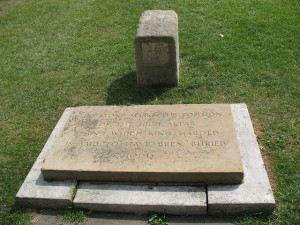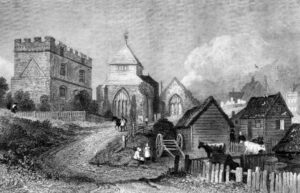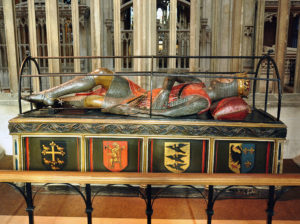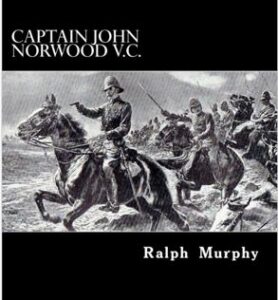GUEST POST BY RALPH MURPHY
Click HERE for Part 1
Some Norwood online trees trace their genealogy directly back to Jordanus de Sheppey, and then to Harold Godwineson as his father, basing this on Marion Norwood Callum’s researches – that cannot be true. The chronology does not hold; court documents for Jordan’s wife and children make it clear that he had to have been born long after Harold Godwinson was dead at Hastings, indeed in 1135.

All of the uncertainty surrounding the descendants of King Harold could be removed if, like Richard III, his body could be found. In the case of Richard, apart from the physical description of the body and its location close to the battlefield etc., proof was found through the DNA of modern supposed descendants. There are many branches of the Norwood family who would be very happy to offer their DNA as proof, including our own! There is controversy however over its location. He had been a benefactor of Waltham Abbey where they claim that a body which was originally under the chancel and was moved later to outside of the Church is Harold II. He has a marked grave in the church yard and the town celebrates his presence; there is at least one society that champions him. But academic opinion is not convinced.
The most detailed medieval account of his location comes from the Waltham Chronicle. The author describes how two canons from Waltham, Osgod Cnoppe and Aethelric Childemaister, accompanied Harold from Waltham to Hastings. After the battle, they asked permission to recover Harold’s body, which could only be identified by his “concubine”, (their pejorative term as clergymen- she was his “hand fast” wife, a recognised Anglo- Scandinavian status) Edith Swans Neck, who recognised “secret marks” on it (only known from their intimate relations.) From Hastings the body was brought to Waltham and buried under the floor of the church. This story was related to the author of the Chronicle when he was a boy, by the Sacristan Turketil, who claimed to have himself been a boy at Waltham when Harold arrived en route from Stamford Bridge, and later witnessed the interment of the king. The author himself claims to have seen Harold’s body being disinterred and moved twice during the rebuilding work which started in 1090.
After the defeat at Hastings, Edith was said to have retreated to Minster on Sheppey where she joined, according to some accounts a nunnery. This too has been challenged, as there was no scope for giving sanctuary as a nun to a prominent figure like Edith, and neither was there an existing community of nuns as the Church had been ruined during the actions by Earl Godwine against Edward the Confessor and therefore it was not in a fit state to serve either as a refuge, or a home for nuns who had already moved on by 1050. The site had a very sad history right through the Anglo Saxon period from the location of a monastery there in 664 through to the 11th century as a result of raids by Vikings. The payment of Danegeld did little to alleviate its suffering. As buildings were made of wattle and daub, they had little resistance to pillage, so by the time of Edward the Confessor in 1042, there was little of the Priory left, probably just a rough settlement around the remains of the Church, and even less after Godwine had done his worst. It is the case however that much later the Abbey was restored and became a priory accommodating wealthy “brides of Christ”.
Moreover, although Edith had some land in Sheppey, according to Domesday, and Thanet her major holdings were in Cambridgeshire, Hertfordshire and East Anglia which was a more natural retreat – she has been linked for example to the foundation to our Lady of Walsingham in Norfolk. But nothing is known for sure and some have speculated that she joined her sons and her husband’s second wife in the abortive attempts to resist Williams rule at Exeter and Bristol. Harold’s wife Aeditha ended her days in St Omer. Edith is said to have died in 1087 but there is no proof that this was in Sheppey.
The family dispersed after the Conquest. Only two members of the family were allowed to live undisturbed in England under Norman rule. Edward the Confessor’s widow Edith, daughter of Godwin, lived in retirement, remaining in possession of all her private lands, until her death in 1075. She was buried near her husband in Westminster Abbey. Her niece Gunnhild, daughter of Harold Godwinson, was an inmate of the nunnery in Wilton until 1093, when she was abducted by Alan the Red, a Breton who held the lordship of Richmond. She lived with him, and then with his successor Alan the Black, after which she disappears from history. The Alans’ goal was evidently to consolidate their hold on land taken from Edith Swans Neck by marrying her daughter.
In the aftermath of the battle of Hastings Godwin’s widow, Gytha, (mother of Harold II) by then in her sixties, withdrew to the south-west of England, where she held vast estates and where resistance to the Conquest was mounting. William the Conqueror turned his attention to crushing this resistance at the beginning of 1068, and laid siege to the city of Exeter, but Gytha had already fled, probably with her daughter Gunhild and Harold’s daughter Gytha, and taken refuge first on an island in the Bristol Channel, probably Flat Holm, and then at Saint-Omer in Flanders.
The young sons of Harold, Godwine and Edmund, and possibly also their brother Magnus, may have been at the siege of Exeter; certainly they made their way to the court of King Diarmalt of Leinster in Ireland, from where they launched two unsuccessful raids against south-west England. Two of the sons, probably Godwin and Edmund, survived to join their relatives in Saint-Omer. From there the whole party seems to have proceeded to Denmark in the hope that its king, Sweyn II, would help them regain their position in England. Sweyn failed them in this, but after a few years he arranged an advantageous marriage for the younger Gytha with Vladimir Monomakh, Prince of Smolensk and later Grand Prince of Kiev. Their descendants intermarried with royal houses across Europe, and transmitted the blood of the Godwins to, among many others, the present Queens of Great Britain and Denmark.
Harold, the youngest and probably posthumous son of Harold Godwinson, was taken by his mother to Dublin, and later went to Norway, where he was welcomed by the king. In 1098 he was one of the men Magnus III Barelegs took with him on an expedition to Orkney, the Isle of Man and Anglesey; the target of this operation, Dublin, was left untouched as the Norwegians retreated home. No further mention of Harold appears in any source. Before passing to the Jordanus connection, it is worth noting that one historian suggests that Alnod/Ulf stayed on in Normandy after being knighted by Robert and changed his name to Loup Fitz Heraut (Wulf, son of Harold) whose signatures have been found in attestations in late 11C charters. Little is known about this knight.

Assertions have been made that Alnod/Ulf lays buried in the Minster Abbey, Isle of Sheppey. There is no proof of this. There are however many other Norwood burials in the Abbey, beginning with Jordanus’ s grandson, Roger de Northwode, which are less contentious. Roger’s father, Sir Stephen de Norwood (Northwood) born c. 1165 built two manor houses, the manor on the Isle of Sheppey was known as “Norwood Manor” within Sheppey and a manor in the Parish of Milton was known as “Norwood without Sheppey” and also known as “Norwood Chasteners.” Stephen is recorded as a son of Jordan de Sheppey, and lived during the reigns of Richard I and King John, (1189 – 1216). His Isle of Sheppey manor was granted by the crown, his mansion was moated around and encompassed within a park, it was well wooded, and said to be stored with an abundance of deer and wild boars. Hence, he assumed the name of Northwood, which was borne by all his descendants.
There is of course a mysterious tomb in the Minster church which was attributed in the Daly book on Sheppey to Jordanus. According to Daly “ In the reign of Henry 1 about AD 1126, the paramount Lord of Sheppey appears to be one Jordanus de Sheppey, or, as it was spelt then “ Sceapiege”. He resided at Northwood Manor, that is to say, the northern Manor immediately adjoining Minster. He died there and was buried, according to Hasted the historian at the Abbey Church of Sexbugha, where his tomb still remains without any inscription or character, though it once had the coat armour, which this family afterwards bore on it. A life size effigy, however, which is now ascribed to him, has been discovered since Hasted wrote (1776); it is deserving of particular attention and is believed to be unique. Of Purbeck marble, it represents a recumbent knight, and was dug up in the churchyard if Minster Abbey in 1833, from about 5 feet below the surface. The hands of the knight are upraised as if in prayer, clasping within them the unique sculptured figure of a soul in prayer also enclosed in a mysterious oval. The Vicar of Minster, the Rev Bramston, is of the opinion that this memorial was probably buried in the churchyard in the troublesome times of the 16th Century.”
In more recent times, the church is more reluctant to ascribe this figure to Jordanus, suggesting that it could belong to the Cheyne family who intermarried with the Norwoods. Close examination of the “soul” also suggests that it is more likely to represent a sheep, the source of wealth in Sheppey at the time. Interestingly, the figure exhibits none of the usual characteristics testifying to participation in the Crusades, such as crossed feet or appropriate weaponry.
When Jordanus died he left an only son Stephen, who assumed the name of Northwood and who succeeded to his father’s estates in Sheppey. He liked like his father in a manor house on the site of the existing more modern house called Norwood manor.
The first time the surname Norwood occurs, is in a court case in the year 1206. At this time, Stephen is also recorded as Stephen, son of Jordan of Sheppey or Stephen son of Cecily. The earliest dated occurrence of Stephen is in the tax rolls for the years 1198-1202 still existing in the public record office in Chancery Lane, London. He occurs with his mother, Cecily, and his brother William. Since Jordanus is not mentioned, he is assumed to be dead by this time.” Stephen’s approximate birthdate of 1165 is based on the fact that he paid to have King John re-confirm his grants that he received from King Richard I around the year 1185. He would have had to be of age at that time so his birthdate is guessed to be the near 1165 figure. [James Dempsey, “Norwood – Northwood families of Kent Warwickshire and Gloucestershire”, 1987]
Stephen’s name can be found in a variety of ways because before the year 1200, the use of surnames or spelling had not been rigidly adopted. In tax rolls for the years 1214 and 1219, Northwood Manor has become well-known enough for Stephen to identify himself as “Stephen of Norwood”.
By far the best short description of the Northwode/Norwood line out of Sheppey is contained in Chapter V11 of Sheila Judge’s book “The Isle of Sheppey” first published in 1983. Sheila details the line from Sir Stephen de Northwode, son of Jordanus, through to John de Northwode who was Constable of the Queensborough Castle in the reign of Edward IV. He was the last male of that line and the Norwood manor was sold and lost its importance. But according to Sheila “The Norwoods were a noble family with a long history. One of the first was a Crusader with Richard I and over the years different members were Sheriffs of Kent; Knights were sent to Westminster, and all of them undertook willingly the commissions that would be expected of a family of their standing. They were a large prolific family, owning large estates in different parts of Kent, where they continued to live for many years after they left Sheppey .”
In her excellent book “Conquered”, sub titled “The Last Children of Anglo Saxon England”, Eleanor Parker of Brasenose traces the lives of the generation of children from the ruling elite born on the eve of the Conquest whose adult lives would be shaped by the new forces. They were entering adulthood, some might choose to play an active part in rebellion against Norman rule, others chose to leave the country or were forced into submission, some did little but watch. They were the last generation of Anglo-Saxon England but they were also the fathers and mothers of the country England was to become.
It is clear that the raids from Ireland with the support of Diarmait, King of Leinster on Bristol, Devon and Cornwall were the last throw of the dice for Harold’s oldest children, Godwine, Edmund and Magnus. Gytha their sister left Flat Holm in the Bristol channel after her effort at Exeter failed and the three eldest of Harold’s children were eventually reunited at the Danish Court. It is possible that Magnus returned to England at some point because there is a medieval monument at Lewes which commemorates Magnus “of Denmark’s royal race” who became an anchorite there. It is clear that by the end of 1066 the English leaders unwilling to accept William had turned to Edgar Aetheling, not the sons of Harold.
Although as written before, Ulf is mentioned in the records as having come into the power of Robert Curthose who also held Duncan, the son of Malcolm of Scotland, according to Parker the Anglo-Norman records are then silent on Ulf’s subsequent fate. Her book goes extensively into the contemporary myth making that produced the English hero Hereward the Wake and the sanctification of Margaret of Scotland, the granddaughter of Edmund Ironside, whose daughter Matilda married Henry 1. She observes that the almost complete disappearance of the grandchildren of Gytha and Godwine from English history after the Conquest is remarkable – although Harold and his brothers were written about in the run up to the 13th century. These stories propagated the myth that Harold had survived Hastings and had come to terms with Norman rule, thereby showing an interest in a King who had lost his kingdom, strength and status but had acquired spiritual power over his conquerors. But no stories were written about his children.
Parker observes that this is more than a simple lack of information. No one is interested in telling stories because for historians in Anglo-Norman England the question of what happened to these children was an awkward subject. To consider their fates worth of investigation might seem tantamount to recognising Harold’s legitimacy as King which was impossible to reconcile with the dominant Norman narrative that “Harold was a grasping usurper who unjustly seized the throne” To address the issue of Harold’s sons and daughters was a more complicated issue and it was perhaps easier and more comfortable to forget the grandchildren of Godwine and Gytha rather than to acknowledge all that they had lost.

This explains why our knowledge of Ulf derives from the various records that I have cited and not from any broader narrative. It would of course have suited Alnod/Ulf well in his process of normanisation if his Anglo- Saxon heritage was not a subject of myth making; Roger Curthose had set him on a new course that lead to the creation of a new generation of Norman knights in Kent.
We know so much about the history of the Norwoods because their genealogy was recorded between 1385 and 1405 with further additions some years later. It was contained in a roll considered to be the work of Thomas Brumpston working for the family and is a very rare chronicle in the Surrenden collection now in the National Archives. However as Sheila Judge says in her book, it omits the perplexing Jordanus of Sheppey entirely. It is probable that unless some hitherto undisclosed documents are found in a forgotten archive, or the body of King Harold is disinterred and DNA tested, the missing link between the Norwoods and the Anglo Saxon King through Alnod/Ulf will never be established. In the meantime, perhaps members of the extended Norwood family should be content that they have an ancestor who fought alongside King Edward 1 at Caerlaverock, another ancestor who accompanied Richard I, Coeur de Lion in the Third Crusade and participated in the battle of Acre, leading to an eventual agreement with Saladin and yet a third fought alongside Henry V at Agincourt, one of the most famous victories in British History.
Whilst on the subject of DNA, if it is the case that Queen Elizabeth II was descended from Harold through Gytha’s marriage to Vladimir Monomakh, Prince of Smolensk and later Grand Prince of Kiev, then her DNA would provide some kind of verification of the Norwood link to Harold. Or, to put it another way, the absence of any common characteristics in the DNA of the Norwoods and the House of Windsor would suggest that the story of a connection with Alnod/Ulf is regrettably not true. I leave it to more intrepid members of the Norwood Clan to take up the matter with Buckingham Palace. Who knows, King Charles might be more amenable to making his DNA available?
Interested in more about the ancestry of John Norwood?
